The Annapurna Base Camp trek is one of the most popular hikes in Nepal.
Why?
Quite simply put: the mountain scenery is incredible.
On this page, you will find a comprehensive and impartial guide to the Annapurna Base Camp hike. Get up close with one of the top 10 highest mountains in the world.
Annapurna Base Camp Hike
To name a few of the mountains you will be trekking amongst, there is Annapurna I (26,505 feet), Annapurna South (23,684 feet), Machapuchhre (22,943 feet) and Hiunchili (21,131 feet). These are arranged in a circle roughly 10 miles wide with a glacier-glazed amphitheatre at the centre which the locals, Gurungs, call the ‘Throne of the Gods' (much like Greece's Mt Olympus). It is more commonly known to Westerners as the Annapurna Sanctuary.
Machapuchhre is considered sacred by Gurungs and climbing it is forbidden, although a British party came within 200 feet in 1957.
The Annapurna Base Camp trek usually takes 10 to 15 days, depending upon how relaxed you take it, and the trek is of moderate difficulty.
Although the valley floor affords good camping if the weather is fair, you will usually stay in one of many Nepal tea houses along the route. Please note that single rooms are rare. Cold showers are free, but hot ones must be paid for. Electricity to charge devices usually costs NPR100 per hour.
The Annapurna Base Camp trek is the only hiking route in the region untouched by road construction. There are more than 100 kinds of mammal in the area, 60 kinds of reptile and amphibians, 450 kinds of birds and nine kinds of rhododendron!
The finest moments of this trek are at sunrise, when the sun dances across the mountains. You will occasionally be granted 360-degree vistas at some of the higher points along the trail.
Annapurna Regional Map
The Annapurna Conservation Area is located in the mid-western part of Nepal, from the Kali Gandaki River in the west to Marshyangdi in the east.
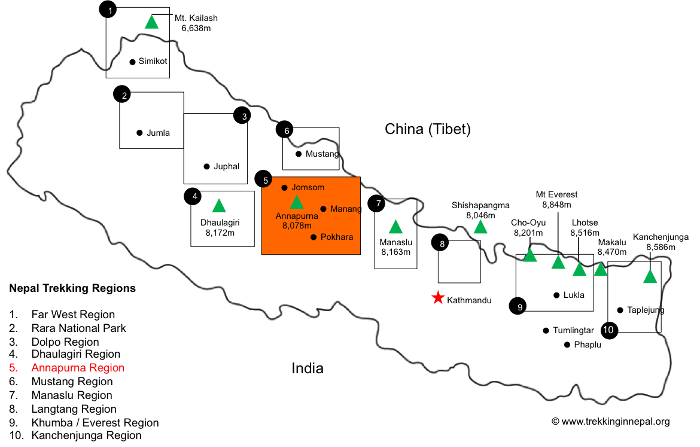
Recommended Annapurna Map
There are quite a few good maps available of the Annapurna region. The one we recommend is called Around Annapurna 1:125 000. It provides full coverage of the Annapurna Conservation Area and Annapurna Sanctuary, with detailed trails, walking distances and altitudes.
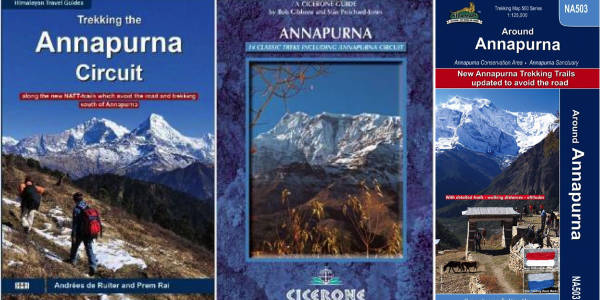
Annapurna Base Camp Itinerary
Please note that there are several Annapurna Base Camp trek itineraries that can be done. Below we have laid out the most popular version – 11 days, including a pre and post stay in Kathmandu. It is possible to do the trek in a shorter time, but you would need to be very fit and well acclimatised. Equally, you could take a few more days and build in some time to rest and acclimatise.
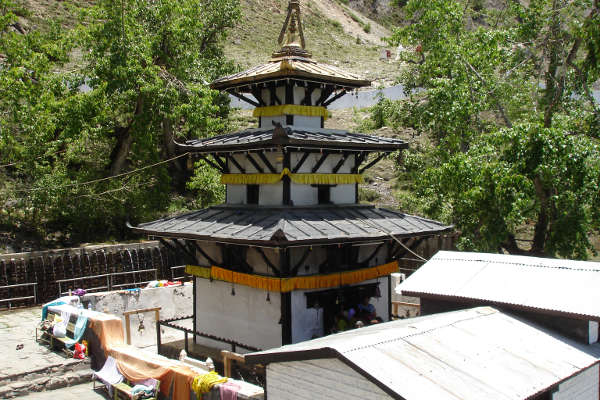
Day 1-2
You will arrive in Kathmandu. Kathmandu is a UNESCO World Heritage Site, so there is much to do, and even if the many sights of cultural and spiritual significance fail to take your fancy, there is a plethora of wide-ranging markets, great bookshops and handicraft and novelty shops.
See here for things to do in Nepal as well as what to do in Kathmandu.
Day 3
You can either fly or get a bus to Pokhara, the second-largest city in Nepal, where the vistas of the Annapurnas are spectacular. Most treks either begin in Phedi or Nayapul, both of which take between 1-2 hours to drive to from Pokhara. Assuming you start from Nayapul, you will trek for 5-6 hours to Ghandruk (from Phedi, you would go to Landruk). Most of the trekking is uphill through amazing forests of mixed oak, rhododendrons and terraced fields.
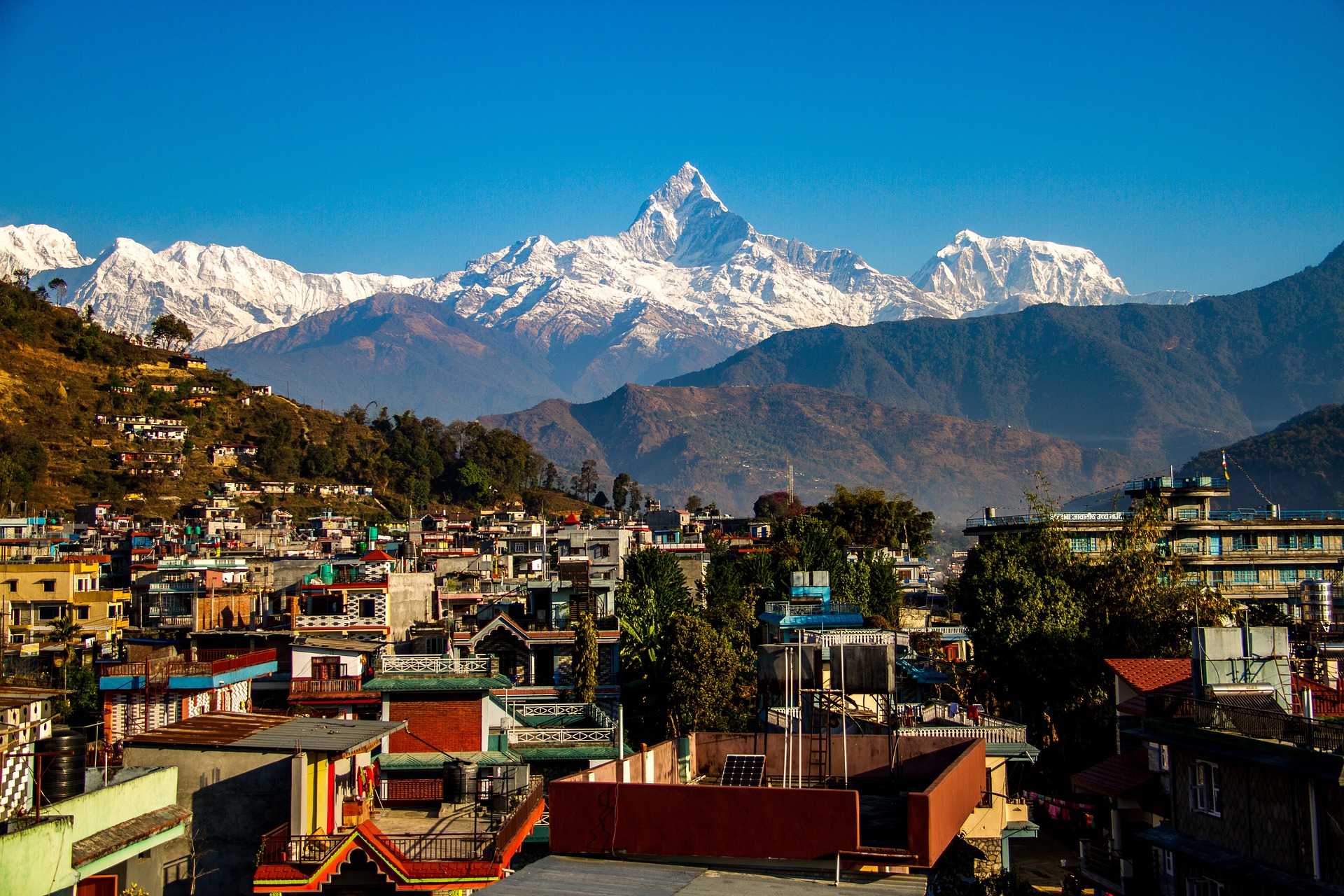
Day 4
From Ghandruk, the trail descends to a river where you will cross at New Bridge. At roughly 1,600 feet you start ascending again. The trail links to another from Landruk. A brief walk, including a stone staircase, will bring you to Chhomrung, a village where there is a gorgeous view of Machhapuchhre (Fish Tail) and Annapurna South. This day covers 5-6 hours of trekking and is quite undulating.
Day 5
One more stone staircase takes you downwards to cross the Chhomrung Khola. You will follow the west bank of the Modi Khola, passing forests of oak, bamboo and rhododendron. You will then ascend to Kuldighar and make your way down a long stone staircase, ending up at the village of Bamboo where you will stay for the night. This is a shorter day (around 4-5 hours).
Day 6
You will pass the remarkable limestone Hinku Caves. The path here is well-defined and undulating, with many stone steps on the way. You will then follow a winding stone path before arriving at the village of Deurali where you can stay for the night. Again, this is another short day which lasts for 3-4 hours.
Day 7
Walking for two or three strenuous hours brings you to Machhapuchare Base Camp, a patch of dirt and rocks – a moraine, as it’s formally known – enclosed by the snow-capped peaks of Annapurnas I and III and Machapuchare. You will be dying for a break here before continuing on into the Annapurna Sanctuary. Shortly thereafter (2 hours), you will reach Annapurna Base Camp, the highest point of the trek (4,130m/13,545ft) where you will stay overnight. This campsite is rudimentary and there are no showers.
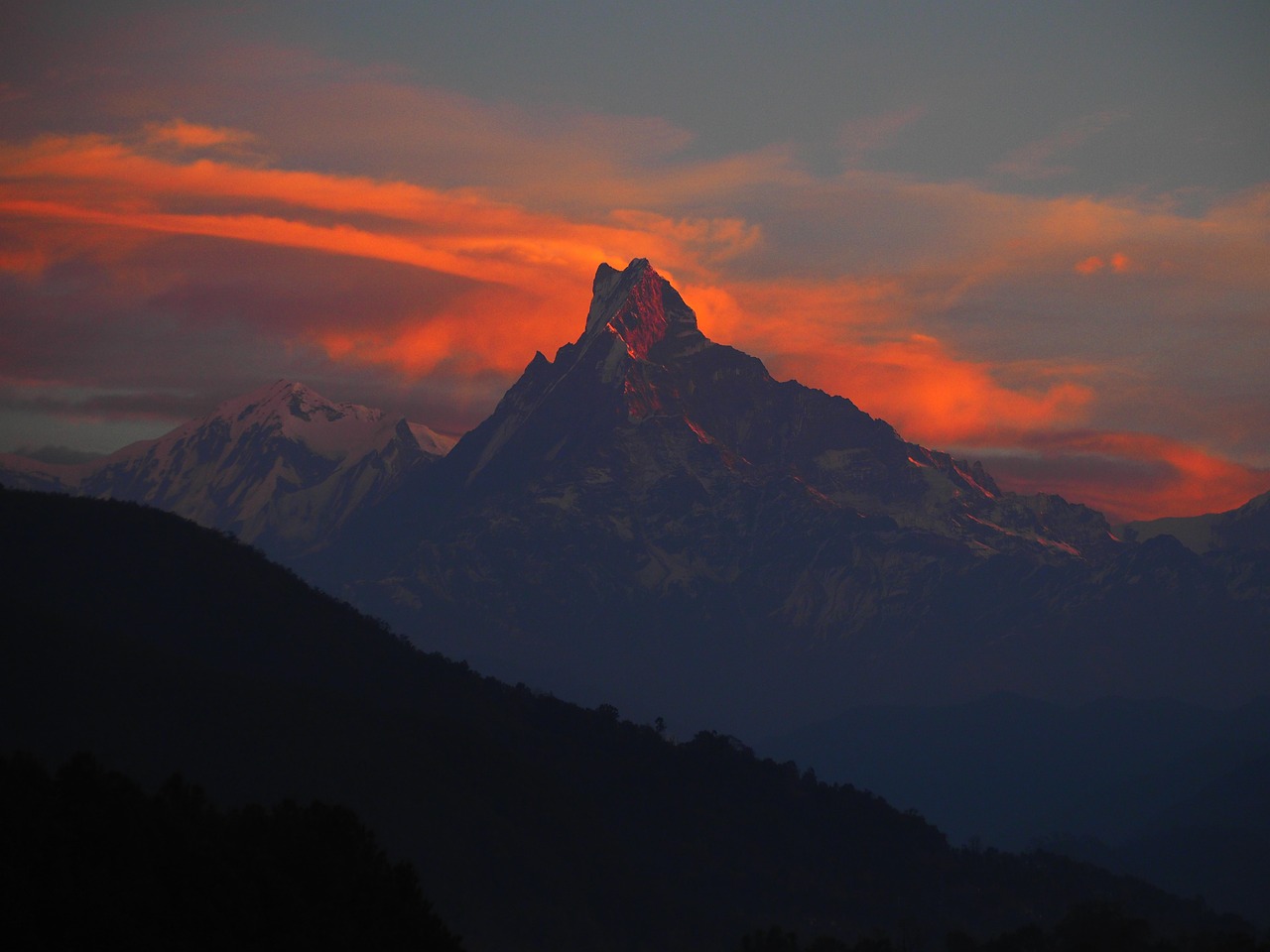
Day 8
Most trekkers either return to Deurali on a different route that generally winds its way downhill or go all the way back to Bamboo. If you choose the latter, it will be about a 7–8-hour trek.
Day 9
It is staircase time once more. This is another long one, with bamboo and rhododendron forests to either side. You go to Kuldighar and Sinuwa, then on to Modi Khola. The day ends with a sheer climb in the direction of Chhomrung, before descending to to Jhinu Danda, which takes about 5-7 hours of trekking. There are hot springs about a 20-minute walk from Jhinu Danda.
Day 10
You will trek through villages and terraced fields, eventually reaching Syauli Bazaar, then Nayapul after another 6 hours of trekking. From Nayapul, the drive back to Pokhara takes about 1-2 hours.
Day 11
The flight back to Kathmandu is spectacular, looking down on the Himalayas.
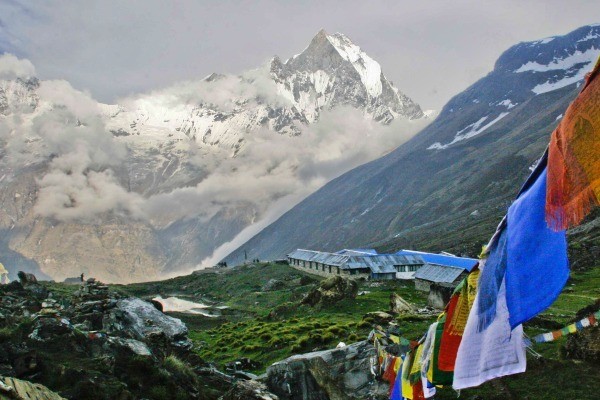
Annapurna Base Camp Trek FAQ
When is the best time to trek to Annapurna Base Camp?
Autumn (September to November) and Spring (March to May) are are the main Nepal trekking seasons and the best times to trek to Annapurna base camp. The rhododendron forests bloom in spring. Taking the trip in winter (December to February) will free you of crowds but the Base Camp is sometimes closed due to snow during this time. The monsoon season (June, July and August) is unpleasant and very wet with lots of leeches.
How much does the Annapurna Base Camp trek cost?
The Annapurna Base Camp trek cost ranges from $1,000 for an unsupported / non-commercial trek (assuming $100 a day is enough to cover all your accommodation needs, food, permits and perhaps some support from a local guide) to $2,500 upwards for an all-inclusive tour with a Nepal trekking company, generally including return flights from Kathmandu to Pokhara.
How difficult is the trek to Annapurna Base Camp?
The Annapurna Base Camp trek is of moderate difficulty. You will be trekking for 4-7 hours a day for over a week, so you will need to be relatively fit. The best way to prepare is to get as many miles as possible under foot on trails in your home country.
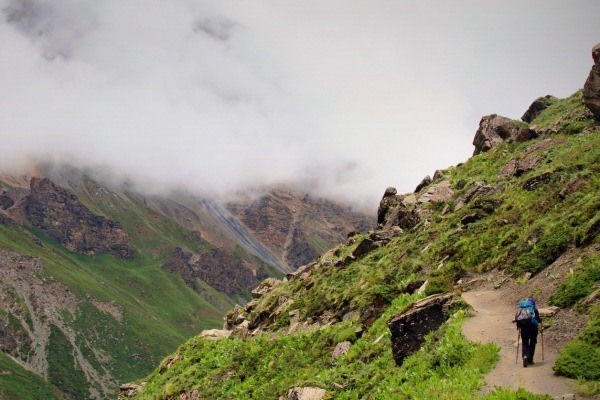
Are permits required for the Annapurna Base Camp trek?
Yes, permits are required for the Annapurna Base Camp trek. You'll need an Annapurna Conservation Area Project permit and Trekker Information Management System registration are in order to do the trek.
If you are joining an organised tour, these will be arranged for you by your tour operator. However, if you are looking to go it alone, you will have to bring four passport-sized photographs with you and go to the offices of the Nepal Tourism Board in Kathmandu to apply. We recommend bringing copies of your passport and insurance policy. The offices follow government working hours and days and are not open on Sundays.
Is altitude sickness a risk on the Annapurna Base Camp trek?
Yes, altitude sickness is a risk on the Annapurna Base Camp Trek because it ascends to some high-altitude points. At its highest point, the Annapurna Base Camp, you will reach an altitude of 4,130 meters (13,545 feet). Luckily, because of the trek's length, the opportunities for acclimatisation are good; hence, the prevalence of moderate or severe altitude sickness is not high.
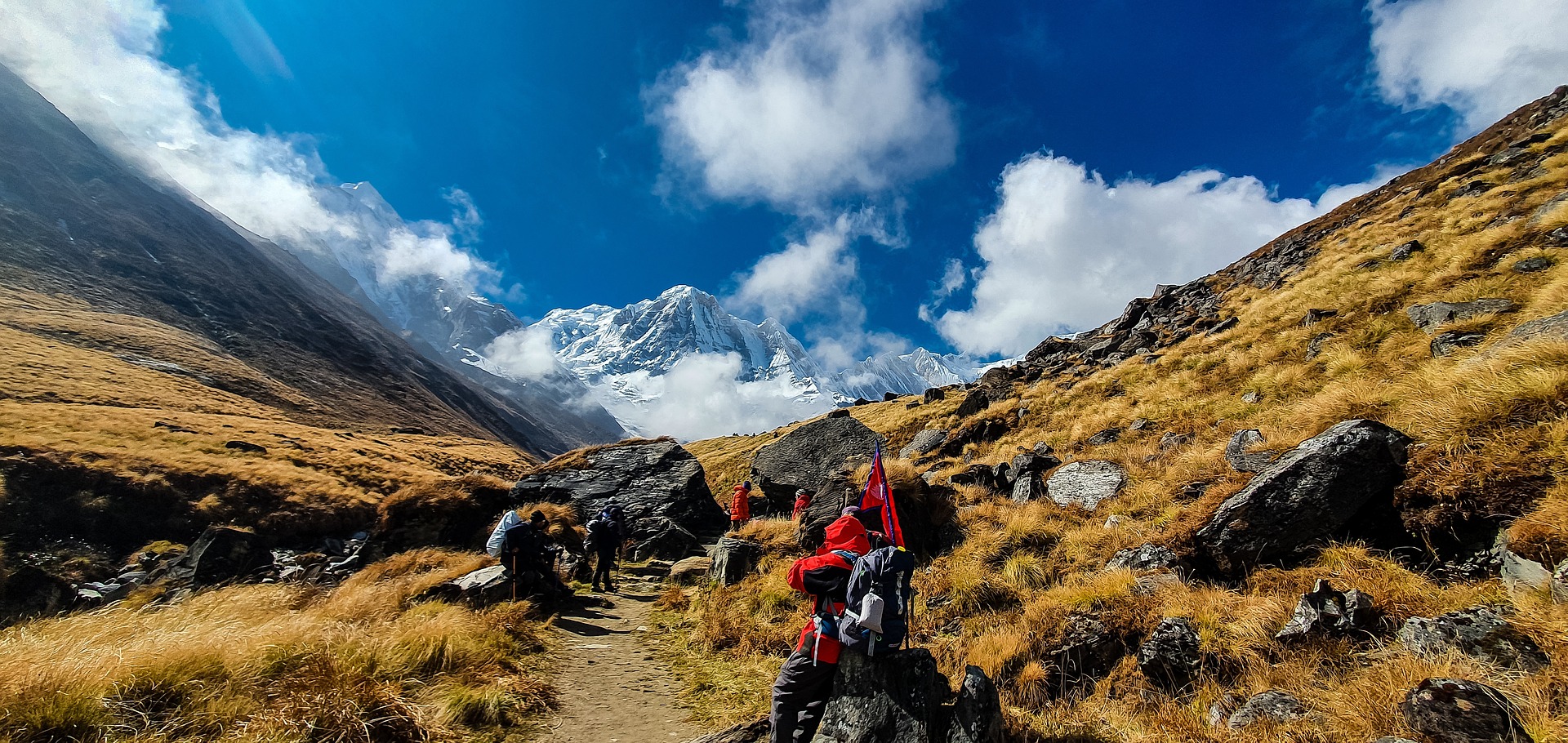
What gear do I need for an Annapurna Base Camp trek?
Trekking the Annapurna Base Camp requires a number of essential pieces of trekking gear and equipment. The Annapurna Base Camp Trek is relatively long and moderately hard. It exposes you to a range of altitudes where temperatures fluctuate significantly between night and day.
Here are some gear items you will need:
- a good quality 4-season sleeping bag
- layered clothing including a base layer, good fleece and warm jacket
- good quality hiking boots and at least 6 pairs of hiking socks
- a warm beanie, sun hat, polarized sunglasses and good gloves
- a 60-70 backpack
- water bottle or hydration pack
- trekking poles
Here is a complete Annapurna Circuit Packing List that would also work well for the hike to Annapurna BC.
What travel insurance do I need for the Annapurna Base Camp trek?
Trekking insurance for Nepal hikes is a good idea. This is particularly true on the Annapurna Base Camp Trek which is remote. If an accident should occur that requires medical assistance and evacuation, you will most certainly want the right trekking insurance that can cover the costs of air ambulance and further treatment.
Make sure to have insurance that covers you for any travel related risks, like damaged, lost, stolen or delayed baggage; flight delays and interruptions; and tour operators' default.
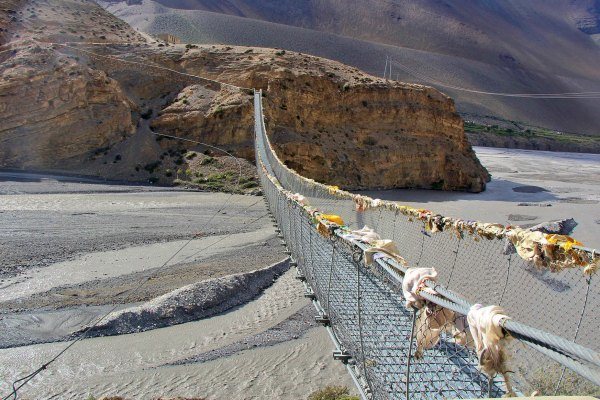
Are there any recommended guidebooks for the Annapurna Base Camp trek?
In terms of guidebooks, we highly recommend Trek to Annapurna Base Camp by Brian Lawrenson or Annapurna: A Trekker’s Guide by Sian Pritchard-Jones and Bob Gibbons.
For amazing photography, check out Annapurna Base Camp Trek: A Photographic Journey by Sanjeev Mathur.
For a super entertaining read on the Annapurna region, we recommend You Couldn’t Make it Up! Ordinary Guy, Extraordinary Life by Mike Freedman.
Can I explore more hikes in Nepal?
Absolutely! There are lots of other great hikes in Nepal which you can explore. Below are some of the most popular hikes in Nepal.
Everest Base Camp
The Everest Base Camp Trek is one of the most popular and iconic treks in Nepal. Trekkers get to retrace the early footsteps taken by Sir Edmund Hillary and Tenzing Norgay on their historic Everest expedition in 1953.
Langtang Valley Trek
The Langtang Valley Trek is a relatively easy trek and is often far less busy than other popular treks in the Everest and Annapurna region. The trek can be done in seven days, however, it usually takes 10 to 12 days.
Manaslu Circuit Trek
Robin Boustead, author of Nepal Trekking & the Great Himalaya Trail: A Route & Planning Guide, pronounced, “Many would argue that the Manaslu Circuit trail is the best general trek in the country.”
Continue browsing
See more information on Nepal. Or check out these other Annapurna hiking articles:

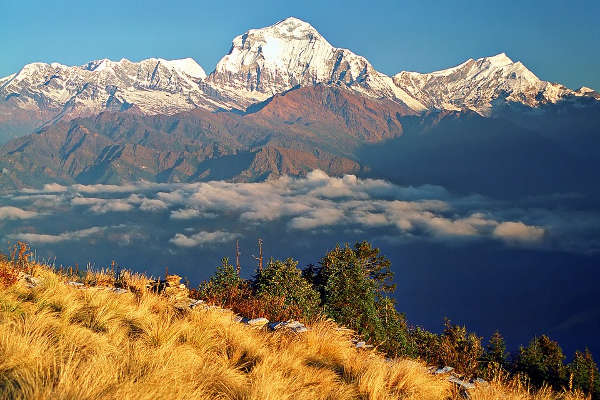
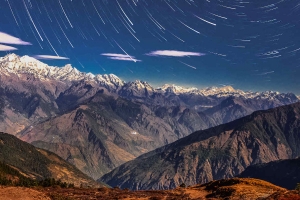
Hi
We are planning a trek to ABC via Poon Hill in May, 2020. Throughout this trip, we would want to book the best available accommodation options.
Before contacting any trek organizing company, I am trying to find out the names of the best guesthouses, preferably with attached toilet.
It would be a great help if you can suggest some names for places such as tikhedhunga, ulleri, ghorepani, tadapani, sinwa, deurali, bamboo, ABC, himalaya, and Jhinu.
Cheers
Indranil